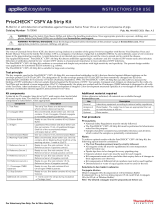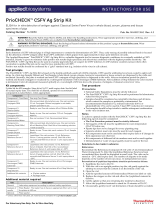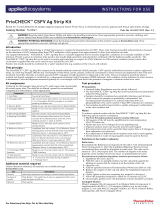Page is loading ...

PrioCHECK™ African Swine Fever Virus Ab Kit
ELISA for in vitro detection of antibodies against African swine fever virus in serum of pigs and wild boars
Catalog NumberA56981
Pub.No. MAN0019591Rev. A.0
WARNING! Read the Safety Data Sheets (SDSs) and follow the handling instructions. Wear appropriate protective eyewear, clothing,
and gloves. Safety Data Sheets (SDSs) are available from thermofisher.com/support.
Technology Species Sample matrix Test type
Indirect ELISA Porcine and wild boar Serum Individual
Product description
The Applied Biosystems™ PrioCHECK™ African Swine Fever Virus Ab Kit (Cat.No.A56981) is an easy‑to‑use ELISA that enables detection of
antibodies directed against the p30 protein of African swine fever virus (ASFV) in porcine serum. The assay meets the sensitivity and specificity
recommendations of the World Organisation for Animal Health (OIE) to detect ASFV infection and is compatible with automated plate washers.
ASFV is a double‑stranded DNA virus of the family Asfarviridae. African swine fever, caused by ASFV, is a highly contagious, lethal disease in pigs
and wild boars that causes high fever, skin and internal organ hemorrhages, and loss of appetite. ASFV spreads rapidly in pig populations through
direct or indirect contact, and through the bite of infected Ornithodoros moubata soft tick species. Outbreaks of ASFV cause severe economic
losses in pig-producing countries, making rapid detection of infected pigs essential to control the disease. Given the long‑term persistence of
anti‑ASFV antibodies after infection, serology tests provide an accurate and easy approach to control the health status of porcine herds and
wildlife (wild boars).
Contents and storage
Reagents and plates for 460 tests are supplied.
Component Amount Storage [1]
1: Test Plate 5 × 12-strip plates[2]
2–8°C
2: Positive Control (PC) 600μL
3: Negative Control (NC) 600μL
4: ASFV Sample Dilution Buer 150mL
5: ASFV Conjugate 60mL
6: Chromogen (TMB) Substrate 60mL
7: Stop Solution 60mL
8: Washing Fluid (20X) 2×60mL[3]
Plate sealers 10
[1] See the label for the expiration date.
[2] Twelve 8‑well strips (coated with ASFV recombinant p30 antigen) in a plate frame;
sealed in a plastic bag with a desiccant sachet.
[3] Sufficient to prepare 2.4L of wash solution (1X).
Required materials not supplied
Unless otherwise indicated, all materials are available through
thermofisher.com.
Item Source[1]
Multiskan™ FC Microplate Photometer, or
equivalent[2] 51119000
Single channel pipette (2–20µL) MLS
Multichannel pipette (50–500µL) MLS
Pipette tips (as recommended by pipette
manufacturer)
thermofisher.com/
pipettetips
Laboratory mixer (vortex or equivalent) MLS
Solution reservoirs MLS
Additional plate (for pre-dilution) MLS
Deionized or distilled water MLS
(Optional) Microplate shaker MLS
(Optional) Wellwash™ Microplate Washer, or
equivalent 5165000
[1] "MLS" indicates that the material is available from fisherscientific.com or another
major laboratory supplier.
[2] Plate reader must be capable of measurement at 450nm.
INSTRUCTIONS FOR USE
For Veterinary Use Only. For In Vitro Use Only.

Workflow
Note: The following times are based on the estimated processing time for one Test Plate.
PrioCHECK™ African Swine Fever Virus Ab Kit workflow
Incubate samples and controls
1. Add ASFV Sample Dilution Buer to all wells of the pre-dilution plate.
2. Add samples and controls to the pre-dilution plate containing ASFV Sample Dilution
Buer (1:50 final dilution), then mix.
3. Transfer the sample dilution to the Test Plate (pre‑coated with ASFV antigen).
4. Incubate at room temperature for 60 minutes.
ASFV‑specific antibodies bind to the antigen, forming antigen‑antibody complexes.
= ASFV antigen (rec. p30 protein)
= ASFV‑specific antibody
65 min
Add ASFV Conjugate
Wash the Test Plate, then incubate the samples with HRP‑labeled ASFV Conjugate for
30 minutes.
The ASFV Conjugate binds to ASFV‑specific antibodies if present in the sample.
= ASFV Conjugate
35min
Perform the substrate reaction, then read the plate
1. Wash the Test Plate, then incubate the samples with Chromogen (TMB) Substrate for
15 minutes.
2. Add Stop Solution to the wells, then read the plate.
Color development indicates the presence of ASFV‑specific antibodies in the sample.
= Chromogen (TMB) Substrate
20min
Analyze the results
1. Ensure the validation criteria are met.
2. Calculate the percent positivity for each sample, then interpret the results.
5min
Procedural guidelines
• Strictly follow all national safety regulations.
• Perform the kit protocol in laboratories that are suited for its
purpose.
• Consider samples as potentially infectious and all items that
contact the samples as potentially contaminated.
• Strictly follow the procedure described in this user guide.
Note: Incubation times can vary ±10% without aecting assay
performance.
• All kit components are ready for use, with the exception of
Washing Fluid (20X).
• Throughout this user guide room temperature is defined as
21±3°C.
• Equilibrate all kit components to room temperature before use.
• Change pipette tips after every pipetting step.
• Maintain separate solution reservoirs for each reagent with the
needed volume to perform the assay. Do not return unused
reagents to the bottle.
• Do not use kit components after their expiry date or if you observe
changes in their appearance.
• Do not mix kit components from dierent kit lot numbers.
• Use deionized or distilled water, or water of equivalent quality.
• Use serum samples that are fresh, refrigerated (<8days at 2–8°C),
or frozen (<1 year at –25°C to –15°C).
•(Recommended) Use a microplate washer for all washing steps.
Insucient washing can result in high background.
Before you begin
Prepare the reagents and Test Plate
• Equilibrate all kit components to room temperature, then gently
mix reagents, samples, and controls.
• Determine the number of 8‑well strips that are required for the
assay, then place the strips in the plate frame.
Seal any unused strips in a plastic bag with the provided
desiccant sachet, then store at 2–8°C for future use.
Prepare wash solution (1X)
1. If Washing Fluid (20X) shows a precipitate, shake the bottle
until the precipitate is dissolved. Alternatively, warm the Washing
Fluid (20X) at 30–40°C with magnetic stirring to accelerate the
dissolution.
2. Prepare wash solution (1X)—Combine 1 part Washing Fluid (20X)
with 19 parts deionized or distilled water, then mix the solution
thoroughly.
Example: For one Test Plate, add 12.5mL of Washing Fluid (20X)
to 237.5 mL of deionized or distilled water.
Note: If a plate washer is used, the volume should be adjusted to
include the volume needed to prime the plate washer.
Store the wash solution (1X) at room temperature for up to one week,
or at 2–8°C for up to one month.
2PrioCHECK™ African Swine Fever Virus Ab Kit Instructions for Use

Perform the ELISA procedure
1. Dilute samples and controls with ASFV Sample Dilution Buer in the pre-dilution plate, according to the
following table.
Depending on the precision pipettes available, the dilution can be performed in one step using 5μL of
sample or two steps using 10μL or 20μL of sample. The one-step dilution and the first step of the
two-step dilution are performed in the pre-dilution plate.
The sample and control final dilutions are a 1:50 ratio.
Component
One-step
dilution Two-step dilution
Well position[1]
Volume for 5‑μL
sample
Volume for
10‑μL sample
Volume for
20‑μL sample
ASFV Sample Dilution
Buer 245μL 90μL 80μL All wells
Positive Control (PC) 5μL 10μL 20μL A1 and B1
Negative Control (NC) 5μL 10μL 20μL C1 and D1
Test sample 5μL 10μL 20μL
One well (single test), or
two adjacent wells (duplicate
test)
[1] Suggested position in the pre-dilution plate.
2. After all samples and controls are dispensed, mix well by pipetting up and down at least 5 times.
3. Transfer each sample and control dilution from the pre-dilution plate to the corresponding wells in the
Test Plate.
If you are performing a two-step dilution, add ASFV Sample Dilution Buer first to the Test Plate.
Component
One-step dilution Two-step dilution
Well position[1]
Volume to
transfer for 5‑μL
sample
Volume to
transfer for 10‑μL
sample
Volume to
transfer for 20‑μL
sample
ASFV Sample Dilution
Buer — 80μL 90μL All wells
Sample or control dilution
from the pre-dilution plate 100µL 20μL 10μL Corresponding well(s) in
the Test Plate
[1] Suggested position in the Test Plate.
4. If the two-step dilution was performed, mix the contents of the wells thoroughly. Use one of the
following methods.
• Using a plate shaker—Cover the plate with a plate sealer, then shake the plate at 600rpm for
1 minute.
• By carefully pipetting—Pipet up and down at least 5 times, then cover the plate with a plate sealer.
5. If the one-step dilution was performed, cover the plate with a plate sealer.
6. Incubate the plate for 60 minutes at room temperature.
1Incubate samples and
controls
1. Empty the Test Plate, then wash the wells 3 times with 350μL/well of wash solution (1X) according to
your washing method.
IMPORTANT! Do not allow the plate to dry out.
•Manual washing—Repeatedly fill, then empty the wells by aspiration or inversion. After the last
wash cycle, tap the plate over a paper towel or absorbent surface to remove as much liquid as
possible from the wells.
•Using an automated plate washer—Wash the wells, following the guidelines for your instrument.
2. Add 100μL of ASFV Conjugate to the Test Plate.
3. Cover the plate with a plate sealer.
4. (Optional) Gently shake the plate.
5. Incubate the plate for 30 minutes at room temperature.
2Add ASFV Conjugate
1. Empty the Test Plate, then wash the wells 3 times with 350μL/well of wash solution (1X) according to
your washing method.
•Manual washing—Repeatedly fill, then empty the wells by aspiration or inversion. After the last
wash cycle, tap the plate over a paper towel or absorbent surface to remove as much liquid as
possible from the wells.
•Using an automated plate washer—Wash the wells, following the guidelines for your instrument.
2. Add 100μL of Chromogen (TMB) Substrate to the Test Plate.
Note: Start the 15-minute incubation time (step3.4) when Chromogen (TMB) Substrate is added to the
first well.
3. (Optional) Gently shake the plate.
4. Incubate the Test Plate for 15 minutes at room temperature in the dark.
3Perform the substrate
reaction, then read the
plate
PrioCHECK™ African Swine Fever Virus Ab Kit Instructions for Use 3

3Perform the
substrate reaction,
then read the plate
(continued)
5. Add 100μL of Stop Solution to the Test Plate in the same order that Chromogen (TMB) Substrate was
dispensed.
6. Gently shake the Test Plate.
7. Measure the optical density (OD) of the wells using a plate reader at 450 nm within 10 minutes after
color development has stopped.
Analyze the results
Calculate the results
1. Calculate the mean OD450 value of the Positive Control (mean of wells A1 and B1 = POS OD450).
2. Calculate the mean OD450 value of the Negative Control (mean of wells C1 and D1 = NEG OD450).
3. Calculate the corrected OD450 of the Positive Control:
Corrected POS OD450 PC=POSOD450−NEGOD450
4. Calculate the corrected OD450 of the test samples:
Corrected Sample OD450=SampleOD450−NEGOD450
5. For each sample, calculate the percentage positivity (PP%):
PP% = (correctedSampleOD450 / correctedPOSOD450)×100
6. Calculate the coecient of variation (CV%) for the Positive Control in OD450 of the duplicates (in wells A1 and B1).
CV% = Standard Deviation (Positive ControlOD450 duplicates) / (POSOD450)
7. Calculate the ratio POSOD450/NEGOD450.
Depending on the plate reader used, an OD450 >3.0 may be observed for some samples. This result can be considered positive, and samples do
not need to be retested.
Validation criteria
If the following criteria are not met, the results are invalid and the samples must be retested.
• The coecient of variation (CV%) between Positive Control OD450 duplicates must be <15%.
• The NEG OD450 must be ≤0.250.
• The POS OD450 must be ≥0.400.
• The ratio of POS OD450 / NEG OD450 should be ≥5.
Interpretation of results
Interpret the results according to the following table.
PP% result Assay result Interpretation
PP%≥25 Positive ASFV‑specific antibodies are present in the test sample.
PP%<25 Negative ASFV‑specific antibodies are not present in the test sample.
Note: PP% results greater than 100 are considered valid and indicate the presence of ASFV‑specific antibodies in the test sample.
Limited product warranty
Life Technologies Corporation and/or its aliate(s) warrant their products as set forth in the Life Technologies' General Terms and Conditions of
Sale at www.thermofisher.com/us/en/home/global/terms-and-conditions.html. If you have any questions, please contact Life Technologies at
www.thermofisher.com/support.
Prionics Lelystad B.V. | Platinastraat 33 | 8211 AR Lelystad | The Netherlands
For descriptions of symbols on product labels or product documents, go to thermofisher.com/symbols-definition.
Revision history:Pub.No.MAN0019591
Revision Date Description
A.0 20 December 2022 New document created for PrioCHECK™ African Swine Fever Virus Ab Kit.
The information in this guide is subject to change without notice.
DISCLAIMER: TO THE EXTENT ALLOWED BY LAW, THERMO FISHER SCIENTIFIC INC. AND/OR ITS AFFILIATE(S) WILL NOT BE LIABLE FOR SPECIAL, INCIDENTAL, INDIRECT,
PUNITIVE, MULTIPLE, OR CONSEQUENTIAL DAMAGES IN CONNECTION WITH OR ARISING FROM THIS DOCUMENT, INCLUDING YOUR USE OF IT.
Important Licensing Information: These products may be covered by one or more Limited Use Label Licenses. By use of these products, you accept the terms and conditions of all
applicable Limited Use Label Licenses.
©2022 Thermo Fisher Scientific Inc. All rights reserved. All trademarks are the property of Thermo Fisher Scientific and its subsidiaries unless otherwise specified.
thermofisher.com/support|thermofisher.com/askaquestion
thermofisher.com
20 December 2022
/









